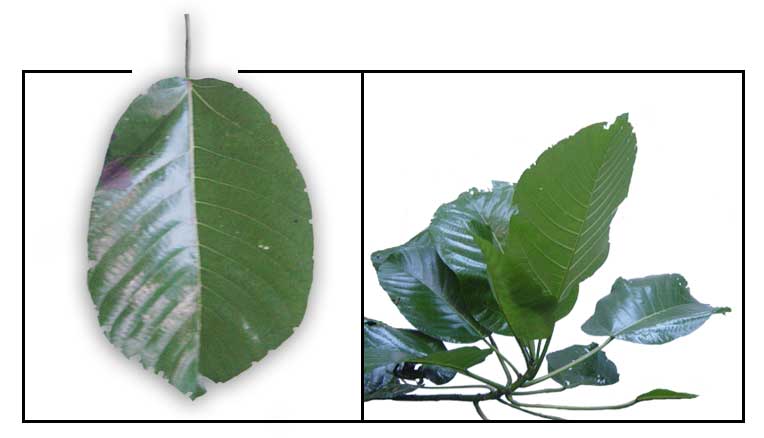| Gen
info
· Laportea meyeniana belongs to the Urticacea (Nettle) family
characterized by the presence of stinging hairs known for causing contact
dermatitis.
· Botanical factoid: Lipa City in Batangas is named after the Urticaceae species Dendrocnide meyeniana, known for the stinging trichomes on its twigs.
 Botany Botany
Lipa is a deciduous shrub or small tree, growing to a height of 3 to
5 meters. Leaves are ovate to broadly elliptic-ovate, 20 to 40 centimeters long,
10 to 22 centimeters wide, entire, with shortly pointed at the tip, and somewhat heart-shaped at the base.
Upper surface is green and smooth, the underside paler and rather densely covered
with numerous, soft and stinging hairs, abundant on the margins of the
leaves. Petioles are about 20 centimeters long. Male inflorescence is axillary,
paniculate, up to 20 centimeters long. Flowers are very numerous, crowded in small
glomerules on the branches, the perianth- segments about 2 millimeters long. Female flowers are
at the end of the branchlets of the inflorescence, 8 to 12, flabellately arranged, and greenish, about 5 to 7
millimeters in diameter. Fruit is small, fleshy, white to pale violet, 5 to 7 millimeters
in diameter.
Distribution
- Native to the Philippines and Taiwan.
-
In thickets, at low and
medium altitudes from northern Luzon to Mindoro and Guimaras.
Constituents
· Phytochemical screening of crude methanol extracts of leaves yielded anthrones, flavonoids, glycosidic flavonoids, phenolic compounds, steroids, tannins, triterpenes, and anthraquinones. (1)
Properties
· Caution: Fresh leaves sting!
· Leaves have numerous, conspicuous stinging hairs. The hairs have a large bulbous base from which projects a long tapering tube that ends in a curved tip that breaks off easily.
· Contact with
the leaves causes breaking of the tips of the hairs and a poison is
released that causes immediate and intense skin irritation. The stings
are painful and may cause the formation of blisters, immediate and possibly
progressing to confluence. Ammonia is used as treatment, rubbed on the
affected part. In rural Quezon, Pungapong is used as a counterirritant,
rubbing the stem juice to the affected parts.
· A study of the Australian species, Laportea gigas Wedd., which resembles Laportea meyeniana, shows it contains ninety times the free acid
of European nettle.
· The poison could be formic and acetic acids, the latter in
greater proportion than the former.
· Although much of the irritation is attributed to formic acid,
some believe it is due to some albuminous poison.
- Studies have suggest antioxidant cytotoxic, penetration enhancing properties.
Parts used
Roots and leaves.
Uses
Edibility
· Roots use for making tea.
- Note: A formulation, Alingatong Miracle Roots Tea, was included in the FDA advisory No 2020-2151, a public health warning on the purchase and consumption of an unregistered product. (11)
Folkloric
· Dried
or powdered leaves use to stop bleeding.
· Leaves used topically to cure carbuncles.
· Pounded roots applied externally for scrofula.
· Decoction used for nosebleeds.
· Infusion of roots and leaves used as diuretic in urinary retention associated with medications, urethral blockage, and obstructive problems caused by benign prostatic hypertrophy, urethral stricture, bladder stones, cystocoele, or tumors.
· Used for treatment of hypertension, diabetes, myoma, and UTIs.
- In Zamboanga del Sur, healers and locals use the wood for treatment of skin rashes, itchiness, carbuncle, furuncle, dermatitis, scabies, arthritis, rheumatism, swollen ankles and feet, kidney problem, flatulence and gas pain (9)
- In Cavite, Philippines, decoction of leaves drunk for abdominal pain. (10)
Studies
* Phytochemicals / Antioxidant / Cytotoxicity: The crude methanolic extracts of four Philippine medicinal plants, including Laportea meyeniana, were studied for their antioxidant and cytotoxic activities. Brine shrimp lethality assay showed 100% mortality at 1000 µg/ml with LC50 of 89.5 µg/ml. (see constituents above) (1)
* Alternative Therapy for Autosensitization Dermatitis : A combination formula of Xiao-feng-san (XFS) and Huang-lian-jie-du-tang (HLJDT) in the form of concentrated herbal extracts was found to be a potential alternative treatment for autosensitization dermatitis caused by Dendrocnide meyeniana. (3)
* Lal lat tan: A wild plant from Imugan, Santa Fe, Nueva Vizcaya, Philippines was subjected to molecular and phylogenetic studies. Using chloroform+methanol solvents, the plant was identified as Dendrocnide meyeniana. Screening for phytochemical constituents yielded saponins, phenols, tannins, flavonoids, anthrones, anthraquinones, terpenes and steroids. (6)
* Enhance Penetration on Transdermal Delivery of Hypoglycemic Compounds: Study evaluated the effect of plants as penetration enhanced on in vivo penetration of insulin and insulin sensitizers (curcumin and rutin) through diabetes-induced mouse skin. Sting crude extracts of Dendrocnide meyeniana were used as penetration enhancers with mouse skin irritation induced by smearing. Results showed enhancers induced a slight erythema without edema on the mouse skin that completely recovered after 6 hours. No damaged cells were found in the HaCaT keratinocytes under sting crude extract treatments. There was a significant decreased in blood sugar level in sensitizer-treated mice. Results suggest safety and an alternative for plants as penetration enhancers. (7)
* Pancreatic Lipase Inhibition / Antioxidant: In a study of 13 endemic medicinal plants for antidiabetic, antiobesity, and antioxidant activities, seven plants, including Dendrocnide meyeniana, showed strong inhibitory activity of >70% against PPL (porcine pancreatic lipase). All the plant extracts showed statistically (p<0.05) higher antioxidant activity compared to vitamin C. (9)
Availability
Wild-crafted. |


![]()

